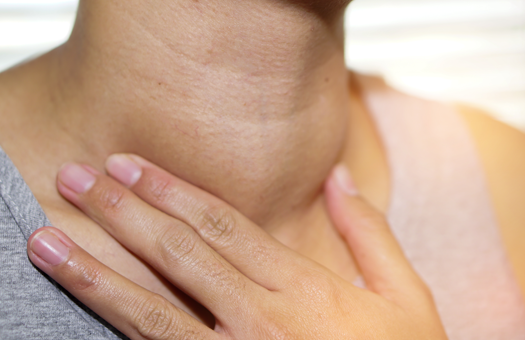Hypothyroidism or what some people may call underactive thyroid gland or thyroid deficiency, is a condition when there is a depletion or lack of thyroid from underactive thyroid glands in the body. Another possible cause is when the body is unable to create thyroid hormones due to the thyroid gland itself and this is called Primary Hypothyroidism. When the disease originates from the pituitary gland or the hypothalamus and affects the function of the thyroid gland, this in turn is called Secondary Hypothyroidism.
The thyroid gland is part of the endocrine system, which is located at the front of the throat, next to the Adam’s apple or thyroid cartilage. It looks like a butterfly and consists of 2 big petals. Both petals are connected to each other by a thin tissue called Isthmus. The normal thyroid gland cannot be seen with the naked eye and cannot be found by palpation.
The thyroid gland produces 3 types of important hormones, which are Thyroxine (T4), Triiodothyronine (T3), and Calcitonin. However, when talking about thyroid hormones, it often refers to only the T4 and T3. They both have very important functions. They supervise the use of energy from food and oxygen for Metabolism plus assist the function of each cell for growth, regeneration and the repair deteriorated cells. In addition, they also control the body temperature. Calcitonin in turn helps to control the functional balance of minerals and calcium in the body.
The thyroid gland works under the supervision of the pituitary gland, which is a part of the brain called Hypothalamus. Both pituitary gland and hypothalamus also control the function of other organs, such as the adrenal gland, ovaries and the male reproduction function. The thyroid gland function is also to produce hormones that regulate the body's metabolic rate which helps to control the heart, body muscle, digestive function, brain and bone development. The functions mentioned ultimately depend on a good supply of iodine from the types of food we eat. Cells producing thyroid hormones are highly specialized in extracting and absorbing iodine from the blood and incorporating it into the thyroid hormones.
Studies have shown that Hypothyroidism frequently occurs in about 2-5% of the general population. Demographic susceptibility research shows that Hypothyroidism can be found in people of all ages, starting from newborn babies (1 in every 3,000 - 4,000 newborn) to the elderly (15% of the elderly, 75 years old and above). Hypothyroidism is also more common in females than males by 2-8 times.

Causes of Hypothyroidism
The common causes of Primary Hypothyroidism are as follow:
-
Thyroiditis cause by the autoimmune response of the thyroid gland
-
Hashimoto’s thyroiditis
-
Thyroidectomy
-
Eating minerals and radioiodine to cure thyrotoxicosis or the thyroid cancer
-
Radiation to cure the cancer in the throat, which will affect the thyroid gland
-
Side effects from some types of medicines that suppress the creation of hormones of the thyroid gland
-
Congenital hypothyroid or the thyroid cell defect from birth
-
Diseases that affect the thyroid gland, such as Scleroderma
The common causes of Secondary Hypothyroidism are as follow:
-
Pituitary tumor
-
Pituitary gland surgery (pituitary tumor removal)
-
Radiation treatment for pituitary tumor
-
Bleeding in the pituitary gland from an accident (accident on the head)
-
Diseases or accidents to the brain that affect the function of hypothalamus, such as tumor and brain cancer

Symptoms of Hypothyroidism
Patients with Hypothyroidism are normally asymptomatic in the early stages. The severity of the symptoms depends on the hormone levels. The symptoms that are common to Hypothyroidism are as follows:
-
Facial swelling, swelling around the eyes, body, arms, hands, legs and feet
-
Bradycardia and fatigue
-
Slow and drowsy
-
Sleepy all the time
-
Slower growth rate in children
-
Constipation
-
Less sweat
-
Intolerance to cold
-
Body temperature lower than normal
-
Hair loss with rough, dry and itchy skin
-
Hardened and brittle nails
-
Thin eyebrows, especially at the end of the eyebrows
-
Frequent muscle cramps and muscle atrophy
-
Joint pain
-
Hoarseness
-
Anemia
-
Lack of concentration
-
Lowers the ability to learn in Children
-
High fat in the blood (Dyslipidemia)
-
Abnormalities menstruation cycle
-
In males, gynecomastia may occur
-
Impotent, sterile, and depressed
-
Some people may have macroglossia and hearing loss
-
Hyperthyroidism or goiter (thyroid gland disease)
Diagnosis
Hypothyroidism can be diagnosed through the following:
-
history of symptoms, illness and previous treatment
-
history of medication
-
physical check-up
-
palpations of the thyroid
-
blood test to check the thyroid hormones
-
hormones related with the thyroid gland and lipid profile

Other examinations like electrocardiogram (ECG) may be requested by the treating doctor, which depends a lot on the patient’s symptoms.
Examination of the thyroid gland can be done by measuring the T4 and T3 in the blood. Both types of hormones are attached with the protein called Thyroid Binding Globulin (TBG). The remaining parts that are not attached to the TGB, are known as Free Hormones. These are the hormones that can be activated with the cells. Therefore at times, patients may also be advised do the Free Hormones (Free T4 or T3) test. In most cases, the Thyroid Stimulating Hormone (TSH) levels will become high and the T4 or T3 in turn will become lower. Therefore, only when TSH levels in the blood become higher, the symptoms of hypothyroidism would be more obvious. Hence, that is why the patients in the early stages are asymptomatic. Therefore, measuring the TSH level in the blood is the most efficient way in diagnosing Hypothyroidism.
Treatment
Conventional treatment approach would normally encompass thyroid replacement hormones. Some patients may be required to take the thyroid hormones throughout their lives. The trend is such that patients normally start with small doses and gradually adjusting the dosage until the T4 and TSH levels are back to normal. TSH should be tested at least once a year in order to titrate the thyroid medications.
However, with the right treatment approach, one may not need to depend only on the medications as mentioned above. Curative pathways through the Integrative treatment approach emphasizes on restoring the cells at a particular or targeted location and using nutrients with active ingredients that can assist in rebalancing the body back to equilibrium has now become the choice of many.
Severity and side effects of Hypothyroidism
Normally, Hypothyroidism is not a severe condition and it can be therapeutically managed. However, thyroid hormones must be taken throughout a patient’s life. The significant side effects of this condition are heart disease, drowsiness, swelling, balance and gait issues, which can have a profound effect the patient. In children, the symptoms include challenges to the mental and growth developments. Do not procrastinate and see your physician if you happen to have any of the symptoms mentioned above.
Prevention
The prevention of Hypothyroidism can be a challenge as the root cause varies. As mentioned earlier, Hypothyroidism can also be caused by the effects of certain types of medication. Therefore, always consult the healthcare professionals, read plus understand the medication information leaflet and know the side effects of the medication that you are taking.
In any case, one of the best ways is to observe one’s own symptoms. If one happen to experience any abnormal symptoms, do see the doctor for a proper diagnosis and early treatment.




Sign In
Create New Account